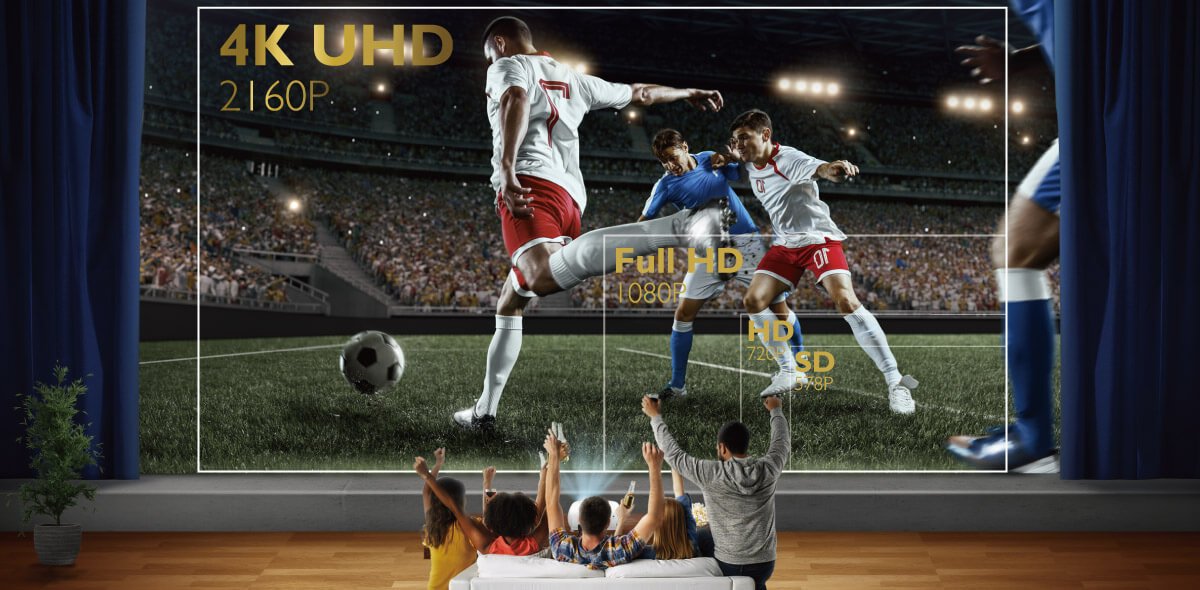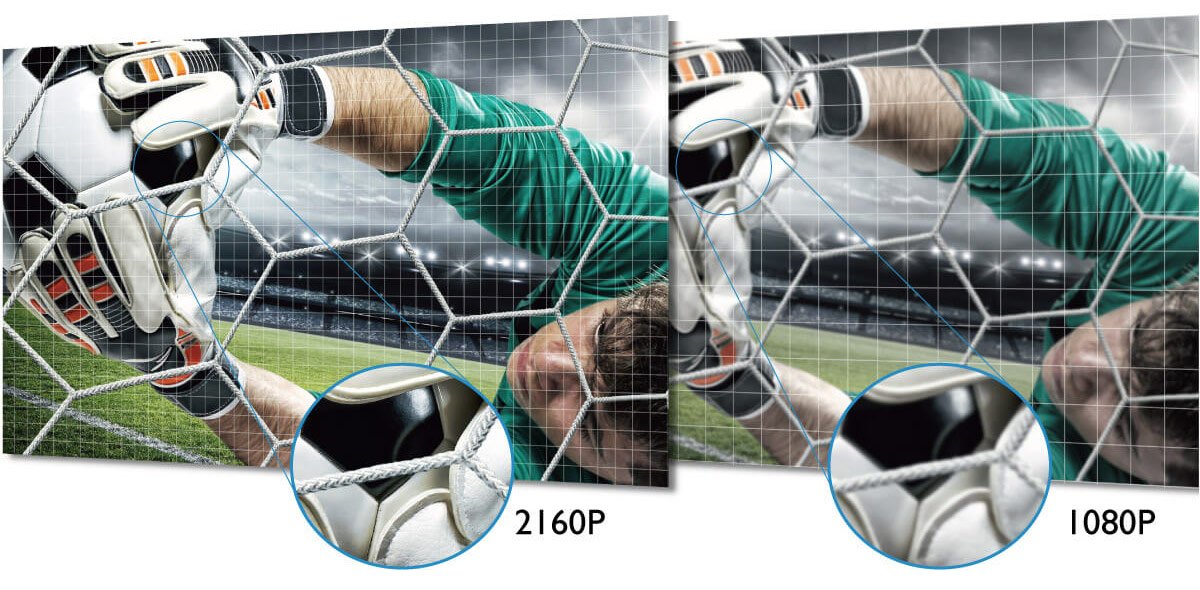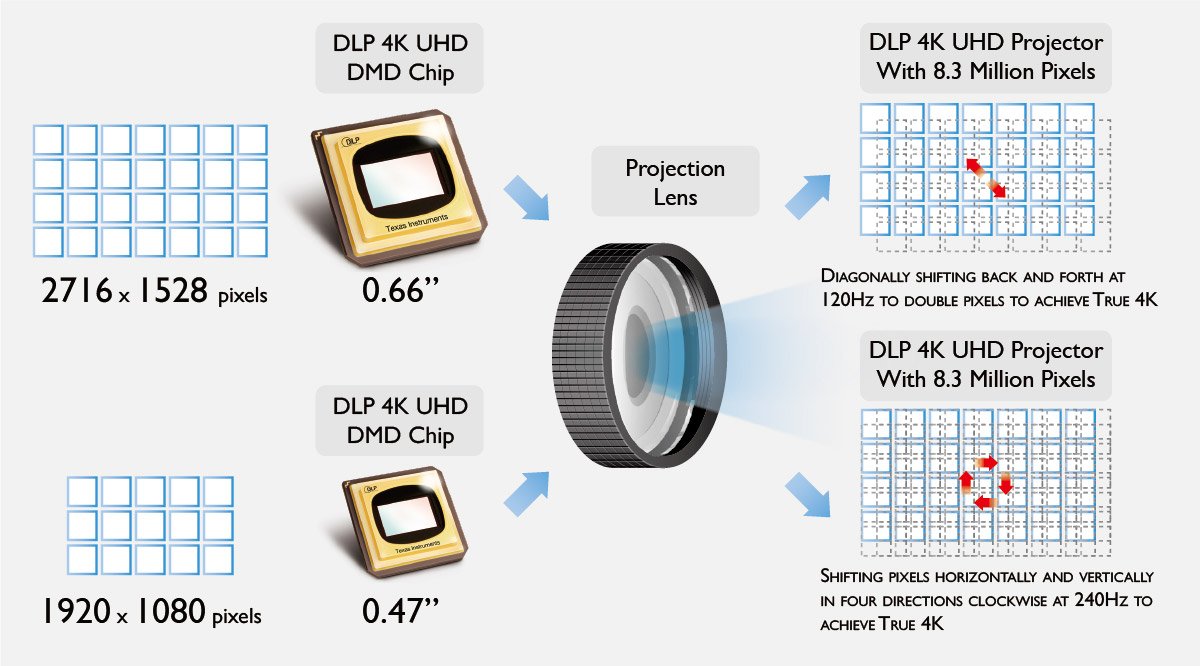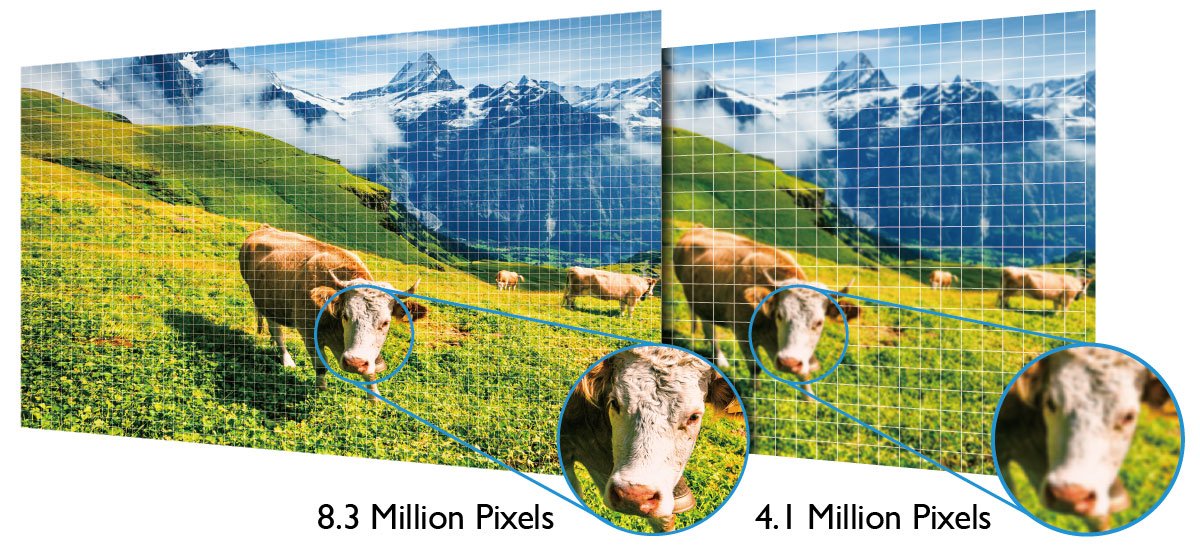Projector
Monitor
Lighting
Digital Display
Job References

There are many components to building your own home theater system, we’ll start with a projector first. For a picture like you see at the cinema you’ll need to get one that’s capable of true 4K resolution. When we talk about 4K for projectors there are generally 2 specs: 3840x2160 or 4096x2160 pixels. The more pixels, the more vivid the picture contents are. Other than resolution, the technology that’s used inside your projector to produce the picture is important too. DLP is the leading projection display technology on the market. The DLP chip inside BenQ’s 4K projectors uses a technology called pixel-shifting, which can achieve true 4K resolution with 8.3 million distinct pixels.
Another key piece to your home theater experience is the source, or what you’re watching. The best picture right now comes from 4K Blu-ray discs using a 4K Blu-ray player. While you may be familiar with Blu-ray, 4K Blu-ray discs have started making their way on the market and offer improved picture quality if you have the right setup to take advantage of it, meaning, a projector capable of 4K, a Blu-ray player capable of playing 4K, and a 4K Blu-ray disc. And so does streaming 4K. We’ve put together a few questions to help you pick out the right 4K DLP projector. These can get a bit technical so feel free to get out your tech acronym dictionary.
According to CTA (Consumers Technology Association), 4K UHD must deliver 8.3 million distinct pixels on the screen, which is four times the resolution of Full HD 1080p.


| Resolution | Horizontal x Vertical Pixels | Total Number of Distinct Pixels | Other Names | Devices |
Resolution 2160p | Horizontal x Vertical Pixels 3840x2160, 4096x2160 | Total Number of Distinct Pixels 8.3+ Million | Other Names 4K, UHD, Ultra HD, Ultra-High Definition | Devices Projectors, TVs |
Resolution WUXGA | Horizontal x Vertical Pixels 1920x1200 | Total Number of Distinct Pixels 2.3 Million | Other Names Widescreen Ultra Extended Graphics Array | Devices Projectors, monitors |
Resolution 1080p | Horizontal x Vertical Pixels 1920x1080 | Total Number of Distinct Pixels 2.1 Million | Other Names Full HD, FHD | Devices Projectors, TVs, monitors |
Resolution 720p | Horizontal x Vertical Pixels 1280x720 | Total Number of Distinct Pixels 0.92 Million | Other Names HD, High Definition | Devices Projectors, TVs |
DLP True 4K UHD Technology is Texas Instruments’ pixel-shifting technology that helps projectors to achieve true 4K resolution with 8.3 million distinct pixels.

True 4K DLP Technology achieves true 4K by producing 8.3 million distinct pixels regardless of the DMD chip’s number of native pixels. In addition to doubling the 0.66” DMD’s 2716x1528 pixels, 4K DLP also perfectly quadruples the 0.47” DMD chip’s 1920x1080 pixels to generate true 4K 8.3 million pixels with lightning-fast pixel shifting speed.
Although both True 4K Technology for DLP projectors and 4K-Enhancement Technology for other projector mechanisms are pixel-shifting technologies, the results they produce are completely different.
• True 4K DLP Technology produces 8.3 million distinct pixels regardless of the DMD chip’s number of native pixels. In addition to doubling the 0.66” DMD’s 2716x1528 pixels, 4K DLP also perfectly quadruples the 0.47” DMD chip’s 1920x1080 pixels to generate true 4K 8.3 million pixels with lightning-fast pixel shifting speed.
• 4K-Enhancement Technology can only produce 4.1 million pixels by doubling the native 1920x1080 pixel resolution, achieving less than half of the required 8.3 million pixels for true 4K resolution.
*This is due to the nature of liquid crystals, which can’t withstand the switching speed required to produce 8.3 million pixels.

• 4K Blu-ray player
• BenQ 4K HDR projector
‧ Make sure source output is set to 3840x2160 at 60 Hz
‧ Make sure the BenQ 4K HDR projector uses the correct HDMI color range (full or limited of RGB, YUV limited). Also be sure to confirm the source player output.
• 4K movies or 4K videos
‧ 4K UHD Blu-ray sets come with two discs: one 1080p disc and one 4K UHD disc. Be sure to use the 4K UHD disc.
• HDMI 2.0 cable connected to HDMI 1 port
| Certification Standard |
Version |
Characteristics |
Remark |
Certification Standard Standard | Version Pre-1.4 | Characteristics Cannot support 4K or HDR | Remark |
Certification Standard High-Speed | Version 1.4 | Characteristics Certified for 4K at 24/30Hz fps only | Remark |
Certification Standard 2.0 | Version Certified for 4K at 60Hz fps | Characteristics | |
Certification Standard 2.0a/b | Version Certified for 4K at 60Hz fps with HDR | Characteristics Great Choice | |
Certification Standard Premium High-Speed | Version N/A | Characteristics Stricter testing for 4K HDR at 60Hz fps and expanded color | Remark Best Choice |
HDCP 2.2 is a copy protection file format, and all standard Blu-ray discs are protected by HDCP 2.2. For those who want to enjoy a smooth Blu-ray disc viewing experience without any hindrance, all associated disc players, amplifiers, projectors, and HDMI cables should be checked for compatibility with HDCP 2.2 decryption, so as to ensure the Blu-ray discs can play properly.
Yes. However, as explained in the question above, since 4K Netflix files are also protected by HDCP 2.2, meaning that for all the Netflix packages you’ve subscribed to, the audiovisual system, the projector, and the HDMI cables used must be compatible with HDCP 2.2. Also, an internet connection speed of at least 25 megabits per second is strongly recommended for an optimal 4K streaming experience. Furthermore, for 4K 60fps video contents, a 4K 60Hz-compatible HDMI cable is also required. (Please refer to the question “Which HDMI Cables Are Needed for 4K HDR?”). For more information regarding Netflix, please refer to their website.
